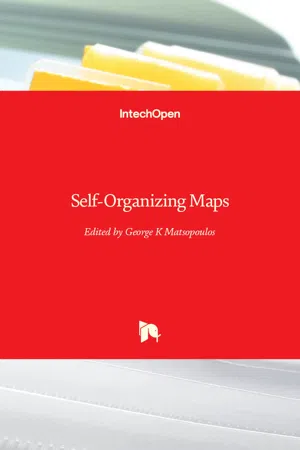
Self-Organizing Maps
George K Matsopoulos
- 432 pages
- English
- PDF
- Available on iOS & Android
Self-Organizing Maps
George K Matsopoulos
About This Book
The Self-Organizing Map (SOM) is a neural network algorithm, which uses a competitive learning technique to train itself in an unsupervised manner. SOMs are different from other artificial neural networks in the sense that they use a neighborhood function to preserve the topological properties of the input space and they have been used to create an ordered representation of multi-dimensional data which simplifies complexity and reveals meaningful relationships. Prof. T. Kohonen in the early 1980s first established the relevant theory and explored possible applications of SOMs. Since then, a number of theoretical and practical applications of SOMs have been reported including clustering, prediction, data representation, classification, visualization, etc. This book was prompted by the desire to bring together some of the more recent theoretical and practical developments on SOMs and to provide the background for future developments in promising directions. The book comprises of 25 Chapters which can be categorized into three broad areas: methodology, visualization and practical applications.
Frequently asked questions
Information
Table of contents
- Self-Organizing Maps
- 1. An Adaptive Fuzzy Neural Network Based on Self-Organizing Map (SOM)
- 2. Learning the number of clusters in Self Organizing Map
- 3. Improvements Quality of Kohonen Maps Using Dimension Reduction Methods
- 4. PartSOM: A Framework for Distributed Data Clustering Using SOM and K-Means
- 5. Kohonen Maps Combined to K-meansin a Two Level Strategy for Time Series Clustering Application to Meteorological and Electricity Load data
- 6. Visual-Interactive Analysis With Self-Organizing Maps - Advances and Research Challenges
- 7. Tracking and Visualization of Cluster Dynamics by Sequence-based SOM
- 8. Visualization with Voronoi Tessellation and Moving Output Units in Self-Organizing Mapof the Real-Number System
- 9. Using Self Organizing Maps for 3D surface and volume adaptive mesh generation
- 10. Neural-Network Enhanced Visualization of High-Dimensional Data
- 11. THE SELF-ORGANZING APPROACH FOR SURFACE RECONSTRUCTION FROM UNSTRUCTURED POINT CLOUDS
- 12. Self-Organizing maps for processing of data with missing values and outliers: application to remote sensing images
- 13. Image Clustering and Evaluation on Impact Perforation Test by Self-Organizing Map
- 14. Self-Organizing Map-based Applications in Remote Sensing
- 15. Segmentation of satellite images using Self-Organizing Maps
- 16. Bridging the Semantic Gap using Human Vision System Inspired Features
- 17. Face Recognition Using Self-Organizing Maps
- 18. Generation of Emotional Feature Space for Facial Expression Recognition Using Self-Mapping
- 19. Fingerprint Matching with Self Organizing Maps
- 20. Multiple Self-Organizing Maps for Control of a Redundant Manipulator with Multiple Cameras
- 21. Tracking English and Translated Arabic News using GHSOM
- 22. Self-organizing Maps in Web Mining and Semantic Web
- 23. Secure Wireless Mesh Network based on Human Immune System and Self-Organizing Map
- 24. A Knowledge Acquisition Method of Judgment Rules for Spam E-mail by using Self Organizing Map and Automatically Defined Groups by Genetic Programming
- 25. Applying an SOM Neural Network to Increase the Lifetime of Battery-Operated Wireless Sensor Networks